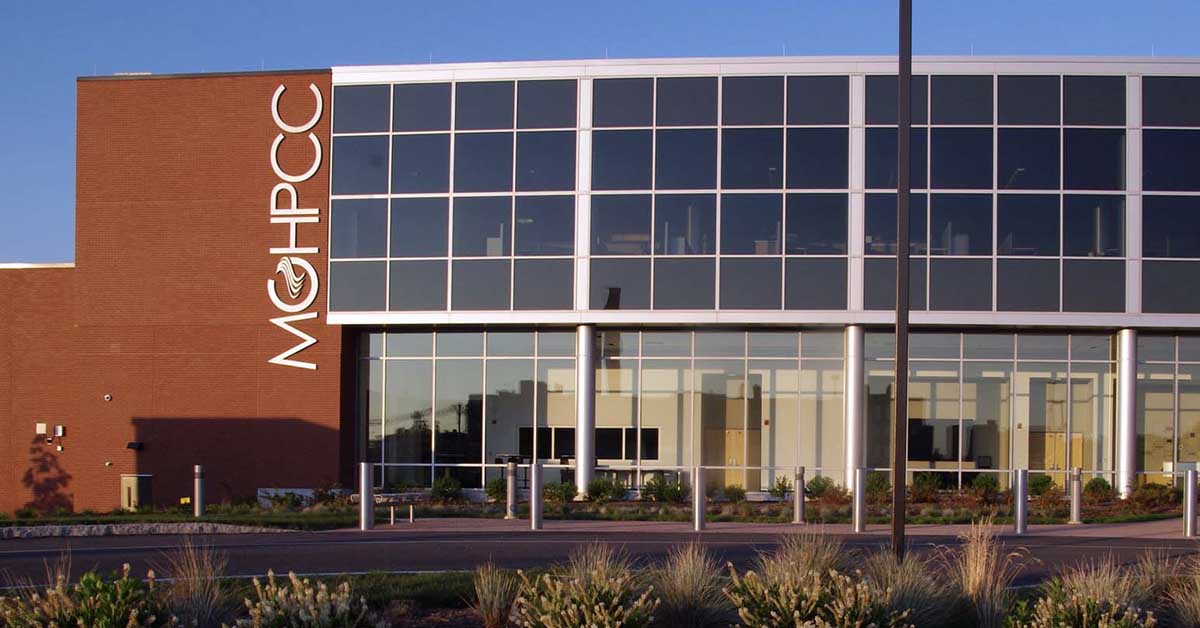From his early days studying computer science and engineering at the Massachusetts Institute of Technology (MIT) to his current leadership role as Executive Director of the Massachusetts Green High-Performance Computing Center (MGHPCC), John Goodhue has blazed a career path at the intersection of networking and computing. “When I was graduating and finishing my last class, I remember my professor telling us about a company in western Cambridge that was working on the Advanced Research Projects Agency Network (ARPANET),” recalls Goodhue. “This pioneering computer network was a precursor to the Internet, and I was able to join their team right out of college. It turned out that they were also working on smaller networks for interconnecting many individual computers and turning them into what we now call clusters.”
Serving on the management teams for several early-stage Boston-area startup companies, Goodhue was at the forefront of the networking field as the Internet was taking shape, playing a pivotal role in the development of foundational technologies that would help shape the digital landscape. “I led the formation of a startup that became the first acquisition of what was an obscure company called Cisco Systems,” says Goodhue. “Starting In 1995 when the commercial internet was starting to explode, I spent nearly ten years building out the Internet and later riding through the crash of 2000. Throughout this period, I discovered I had a real passion for leading teams who could turn ideas into reality. Along the way, I’ve learned that being a good leader means taking time to understand people and resolve disputes within your team, often doing so between individuals who are smarter than you.”
Supporting Growing Computing Needs
With experience leading initiatives to advance Internet routing and high-performance computing technologies, Goodhue joined MGHPCC as the executive director in 2010. “At the time, the organization was still a startup,” says Goodhue. “We built a facility, assembled a consortium, and it’s now a thriving high-performance computing center with an emphasis on green, sustainable computing.”
Designed to serve the growing scientific and engineering computing needs at six of the most research-intensive universities in the northeast, MGHPCC is a joint venture of Boston University, Harvard University, MIT, Northeastern University, The University of Massachusetts, and Yale University. “At any given time, there are 20,000 people who use resources in the Center to advance their state-of-the-art research and education,” says Goodhue. “We provide a crucial infrastructure that underpins the scientific world in our field—without it, they wouldn’t be able to do what they do. The excitement of working at the center is similar to the first time I built a small scientific instrument as a student. When I was working on a piece of the instrument late one night someone stopped, looked at their results and said, ‘This is amazing. I now see that things I thought were true are not quite right, so I must rethink everything and approach what I’m doing in a different way.’ Seeing that kind of discovery, that spark in someone’s eyes, is at the core of why what we do matters.”
“Research and education networks like Edge are the bedrock of research collaboration, playing a crucial role in supporting scientific discovery, advancing innovation, and ensuring that researchers can keep pace with rapidly evolving technology. As foundational pillars of collaboration, RENs enable the seamless exchange of ideas, data, and resources across institutions, fostering a global community of scholars and innovators.”
— John Goodhue
Executive Director, Massachusetts Green High-Performance Computing Center (MGHPCC)

“We’re at a really interesting time when it comes to technology. The amount of power consumed per square foot by newer GPU-based computers has increased by a factor of five or ten. From a facility perspective, this means we must make significant changes. On the architecture side, the rise of GPUs introduces new programming techniques.. With the advent of artificial intelligence (AI), we now have an entirely new software ecosystem to manage, and the introduction of orchestrated versus batch-scheduled workloads adds another layer of complexity. These are all challenges we are able to address collectively, rather than everyone learning the same thing multiple times. This approach has made a huge difference, and as technology continues to evolve, we’ll be able to support each other, stay ahead of the curve, and ensure that our infrastructure and expertise evolve in tandem with these advances.”
 The MGHPCC facility includes 33,000 square feet of dedicated computer room space, designed specifically for high-performance computing systems. The building is powered by a 20MW feed and features a highly efficient cooling system that supports a Power Usage Effectiveness of 1.2. “Many of the decisions that have shaped our environmental impact at MGHPCC were made early on, including the site where we chose to build,” explains Goodhue. “Located in Massachusetts, our principal environmental impact today is the consumption of electricity. From the outset, we made the conscious decision to build on a brownfield site rather than a greenfield site, avoiding the disruption of undeveloped land. This choice was followed by six months of environmental remediation before construction began.”
The MGHPCC facility includes 33,000 square feet of dedicated computer room space, designed specifically for high-performance computing systems. The building is powered by a 20MW feed and features a highly efficient cooling system that supports a Power Usage Effectiveness of 1.2. “Many of the decisions that have shaped our environmental impact at MGHPCC were made early on, including the site where we chose to build,” explains Goodhue. “Located in Massachusetts, our principal environmental impact today is the consumption of electricity. From the outset, we made the conscious decision to build on a brownfield site rather than a greenfield site, avoiding the disruption of undeveloped land. This choice was followed by six months of environmental remediation before construction began.”
With a focus on maximizing energy efficiency while minimizing negative environmental impacts, MGHPCC is among the top ten percent of energy efficient data centers in the world. “We improved an existing industrial location, minimizing our impact on the environment,” shares Goodhue. “Additionally, we focused on sustainable design by building a LEED Platinum-certified facility, paying close attention to every detail, from recycling materials to selecting eco-friendly cleaning products. Environmental impact is often a battle of inches—small decisions that, when made thoughtfully, add up to a significant positive effect. The electricity we consume also reflects deliberate choices. Located in western Massachusetts, we benefit from a less-loaded grid and easy access to electricity. Moreover, we’re situated just half a mile from a hydroelectric facility that generates far more electricity than we actually consume, making our energy usage even more sustainable.”
Regional and National Collaboration
Through initiatives like the Northeast Storage Exchange, the Open Storage Network (OSN), Ecosystem for Research Computing, and the Northeast Big Data Hub, MGHPCC has contributed to collaborations across institutions and helped strengthen the research computing ecosystem. “There are two key ways in which we achieve efficiency,” says Goodhue. “First, by leveraging economies of scale—when more people use the same resources—we reduce operating costs and improve efficiency. The fixed operating costs are spread across a larger user base, making it less expensive for all. The second benefit is providing the opportunity for people to learn from each other. That collaborative learning is incredibly important to solving problems and advancing scientific discovery.”
“The sharing of knowledge is just as important as any economic benefit,” continues Goodhue. “For example, the Open Storage Network (OSN) sponsored by the National Science Foundation (NSF) is a network of storage devices that is now spread across nearly twenty locations. Each site benefits from the collective design and development efforts. It’s a collaborative effort between MGHPCC, the San Diego Supercomputing Center, the National Center for Supercomputing Applications, the Renaissance Computing Institute (RENCI), and Johns Hopkins University. Each partner brings unique expertise, and when a challenge arises or a change is needed, there’s always someone with the right experience to guide us. The whole is truly greater than the sum of its parts when it comes to sharing knowledge, insight, and lessons learned.”
To bring advanced computing resources to researchers at smaller institutions in northern New England, MGHPCC contributed to the formation of the Northeast Cyberteam, a partnership between MGHPCC, University of Maine, University of New Hampshire, and University of Vermont. “Smaller institutions often face constraints, where educators are focused on teaching, but want to incorporate research computing into their work,” says Goodhue. “Researchers often want to continue their work from when they were graduate students, but most institutions can’t provide the necessary computing resources. While the gap in available resources is a challenge, it’s one that’s relatively easy to address. The bigger issue lies in finding research computing facilitators who can bridge the gap and make it easier for researchers to access and use the necessary technology.”
 “To make the best use of computing resources, we need to bring in people who can help,” continues Goodhue. “The NSF funded a project where we recruited experts from larger universities to mentor students. These students learned how to be facilitators and assist researchers at smaller institutions in getting up and running. This initiative worked out well, and in many cases, the students’ contributions resulted in their names being included in published papers. Over time, we also built a network large enough to rely on and connect with people who needed important resources.”
“To make the best use of computing resources, we need to bring in people who can help,” continues Goodhue. “The NSF funded a project where we recruited experts from larger universities to mentor students. These students learned how to be facilitators and assist researchers at smaller institutions in getting up and running. This initiative worked out well, and in many cases, the students’ contributions resulted in their names being included in published papers. Over time, we also built a network large enough to rely on and connect with people who needed important resources.”
To further the goals of broadening participation in computing set by its founding members, MGHPCC and its members partner with local, regional, and national education programs. For example, interns at the MGHPCC engage with a range of high-performance computing hardware and software systems, beginning with foundational readings and exercises on the Linux operating system, system administration tools, and Python scripting. They then progress to hands-on tasks, with assignments tailored to their skills and the specific needs of the program. “Finding trained individuals who are well-versed in running high-performance computing systems is challenging,” says Goodhue. “Our internship program offers a way for local community college students to gain the necessary experience. This program provides practical experience, advanced skill building, and opens the door to new opportunities, helping to broaden their horizons in technology.”
Expanding Collaborative Efforts
As high-performance computing continues to evolve, Goodhue says expanding collaborative efforts and fostering interdisciplinary partnerships will be essential for driving innovation and addressing the growing demands of complex computational challenges. “All of our team members from the six institutions have unique knowledge and experience and we leverage those strengths to create solutions that are more impactful and far-reaching than we could achieve individually, enabling us to tackle challenges more effectively and efficiently.”
“At any given time, there are 20,000 people who use resources in the Center to advance their state-of-the-art research and education. We provide a crucial infrastructure that underpins the scientific world in our field—without it, they wouldn’t be able to do what they do. The excitement of working at the center is similar to the first time I built a small scientific instrument as a student. When I was working on a piece of the instrument late one night someone stopped, looked at their results and said, ‘This is amazing. I now see that things I thought were true are not quite right, so I must rethink everything and approach what I’m doing in a different way.’ Seeing that kind of discovery, that spark in someone’s eyes, is at the core of why what we do matters.”
— John Goodhue
Executive Director, Massachusetts Green High-Performance Computing Center (MGHPCC)

With a focus on maximizing energy efficiency while minimizing negative environmental impacts, MGHPCC is among the top ten percent of energy efficient data centers in the world.
“We’re at a really interesting time when it comes to technology,” continues Goodhue. “The amount of power consumed per square foot by newer GPU-based computers has increased by a factor of five or ten. From a facility perspective, this means we must make significant changes. On the architecture side, the rise of GPUs introduces new programming techniques.. With the advent of artificial intelligence (AI), we now have an entirely new software ecosystem to manage, and the introduction of orchestrated versus batch-scheduled workloads adds another layer of complexity. These are all challenges we are able to address collectively, rather than everyone learning the same thing multiple times. This approach has made a huge difference, and as technology continues to evolve, we’ll be able to support each other, stay ahead of the curve, and ensure that our infrastructure and expertise evolve in tandem with these advances.”
As AI becomes more integrated into the research and education space, Goodhue says there will be many factors to consider. “From an infrastructure point of view, the programming techniques, power consumption, and other factors are already shaping the near future. Looking at the broader commercial space, the explosion of AI-based applications has been far more rapid than the introduction of new apps during the iPhone era. It’s much easier to instruct AI to perform tasks than it is to program an iPhone with complex code, so AI is making new ideas more accessible and will drive significant change as a result.”
Looking further ahead, he notes that quantum computing is a different challenge. “Quantum has the potential to be transformative for specific, important applications, but it’s not quite there yet. We’re moving out of the research phase and into engineering, but there’s still much work to be done. In the near future, our focus will be on ensuring that the best quantum resources are available to researchers, helping them bridge the gap between potential and practical solutions. We must remember that every overnight success is often the result of decades of hard work.”
To enable seamless access to cutting-edge technologies and foster collaboration, Goodhue says research and education networks (RENs) help break down barriers and create opportunities for researchers and institutions to work together more effectively, regardless of geographic or institutional limitations. “Research and education networks (RENs) like Edge are the bedrock of research collaboration, playing a crucial role in supporting scientific discovery, advancing innovation, and ensuring that researchers can keep pace with rapidly evolving technology. As foundational pillars of collaboration, RENs enable the seamless exchange of ideas, data, and resources across institutions, fostering a global community of scholars and innovators.”
In discussing her experience working with Goodhue, Dr. Forough Ghahramani, Assistant Vice President for Research, Innovation, and Sponsored Programs, Edge, says, “As the driving force behind the exceptional capabilities available through MGHPCC, John ensures that researchers and institutions across the region can fully leverage its resources to drive innovation and discovery, fostering transformative advancements in research computing. It has been an honor to serve on several regional and national committees alongside a visionary leader like John, whose collaborative approach and generosity in sharing his expertise were instrumental in shaping Edge’s recent NSF Campus Cyberinfrastructure Regional Connectivity project.”
“Quantum has the potential to be transformative for specific, important applications, but it’s not quite there yet. We’re moving out of the research phase and into engineering, but there’s still much work to be done. In the near future, our focus will be on ensuring that the best quantum resources are available to researchers, helping them bridge the gap between potential and practical solutions. We must remember that every overnight success is often the result of decades of hard work.”
— John Goodhue
Executive Director, Massachusetts Green High-Performance Computing Center (MGHPCC)
Becoming a Balanced Leader
Drawing on his extensive experience in both industry and academia, Goodhue encourages emerging leaders to explore different ways they can make an impact in high-performance computing and collaborative infrastructure. “My advice is to think carefully about when you are ready to step out of an individual contributor role and into leadership, because once you make that change, it can be difficult to shift back. Also understand that technical leadership is distinct from traditional management, and both are valuable skills. It’s not necessary to be a manager to lead—leadership comes in many forms, and embracing your technical expertise can be just as impactful as overseeing a team.”
For those on a career track that includes leadership opportunities, Goodhue emphasizes the importance of preparation and self-awareness. “As you take on leadership roles throughout your career, especially coming from a technical or specialized background, take the time to learn about people management and the broader organizational dynamics. Leadership isn’t just about overseeing tasks; it’s about understanding the human side of organizations, which can often be challenging. You must familiarize yourself with the broader aspects of organizational operations, such as profit and loss statements, project budgets, and other financial aspects that will influence your decisions and responsibilities. Successful leadership is not only about technical expertise, but about growing as a well-rounded individual who can inspire others, promote constructive conversations, and guide their organization to thrive in a complex, ever-changing world.”
Learn more about the Massachusetts Green High Performance Computing Center at www.mghpcc.org.



